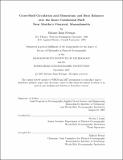Cross-shelf circulation and momentum and heat balances over the inner continental shelf near Martha's Vineyard, Massachusetts
Author(s)
Fewings, Melanie Rinn
DownloadFull printable version (10.25Mb)
Other Contributors
Woods Hole Oceanographic Institution.
Advisor
Steven J. Lentz.
Terms of use
Metadata
Show full item recordAbstract
The water circulation and evolution of water temperature over the inner continental shelf are investigated using observations of water velocity, temperature, density, and bottom pressure; surface gravity waves; wind stress; and heat flux between the ocean and atmosphere during 2001-2007. When waves are small, cross-shelf wind stress is the dominant mechanism driving cross-shelf circulation. The along-shelf wind stress does not drive a substantial cross-shelf circulation. The response to a given wind stress is stronger in summer than winter. The cross-shelf transport in the surface layer during winter agrees with a two-dimensional, unstratified model. During large waves and onshore winds the crossshelf velocity is nearly vertically uniform, because the wind- and wave-driven shears cancel. During large waves and offshore winds the velocity is strongly vertically sheared because the wind- and wave-driven shears have the same sign. The subtidal, depth-average cross-shelf momentum balance is a combination of geostrophic balance and a coastal set-up and set-down balance driven by the cross-shelf wind stress. The estimated wave radiation stress gradient is also large. The dominant along-shelf momentum balance is between the wind stress and pressure gradient, but the bottom stress, acceleration, Coriolis, Hasselmann wave stress, and nonlinear advection are not negligible. The fluctuating along-shelf pressure gradient is a local sea level response to wind forcing, not a remotely generated pressure gradient. In summer, the water is persistently cooled due to a mean upwelling circulation. The cross-shelf heat flux nearly balances the strong surface heating throughout mid-summer, so the water temperature is almost constant. The along-shelf heat flux divergence is apparently small. In winter, the change in water temperature is closer to that expected due to the surface cooling. Heat transport due to surface gravity waves is substantial.
Description
Thesis (Ph. D.)--Joint Program in Oceanography/Applied Ocean Science and Engineering (Massachusetts Institute of Technology, Dept. of Earth, Atmospheric, and Planetary Sciences; and the Woods Hole Oceanographic Institution), 2007. This electronic version was submitted by the student author. The certified thesis is available in the Institute Archives and Special Collections. Includes bibliographical references (p. 257-267).
Date issued
2007Department
Joint Program in Oceanography/Applied Ocean Science and Engineering; Woods Hole Oceanographic Institution; Massachusetts Institute of Technology. Department of Earth, Atmospheric, and Planetary SciencesPublisher
Massachusetts Institute of Technology
Keywords
/Woods Hole Oceanographic Institution. Joint Program in Oceanography/Applied Ocean Science and Engineering., Earth, Atmospheric, and Planetary Sciences., Woods Hole Oceanographic Institution.